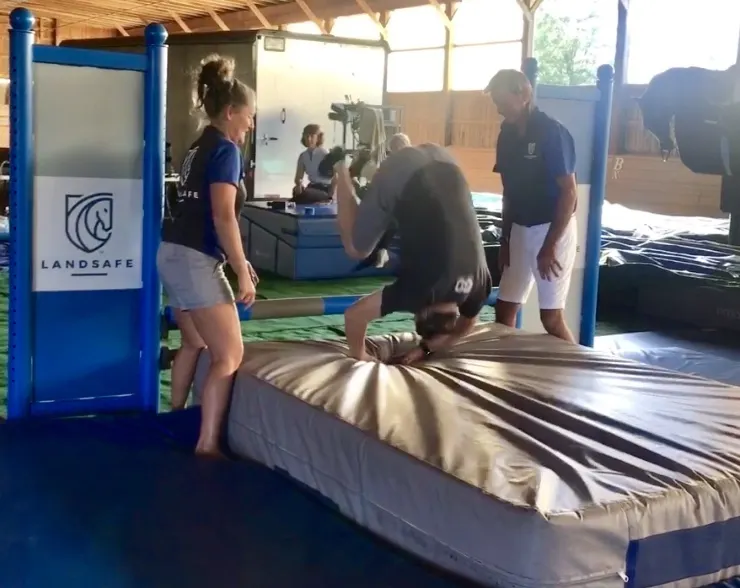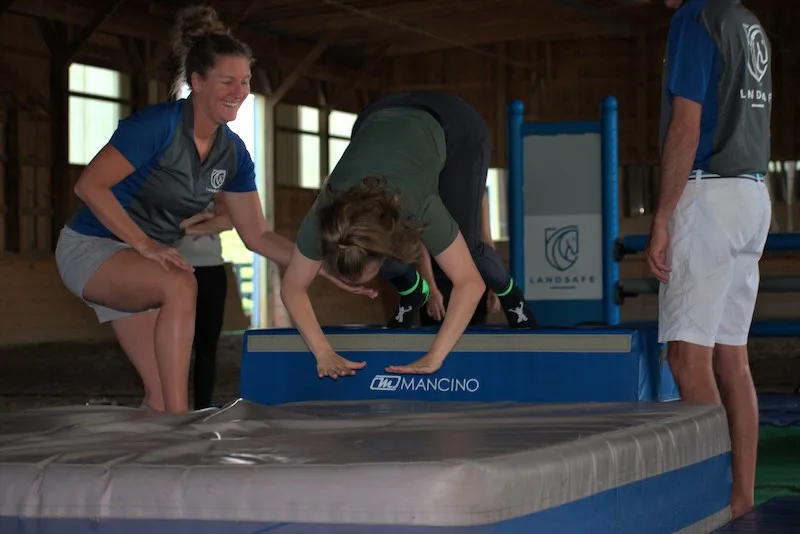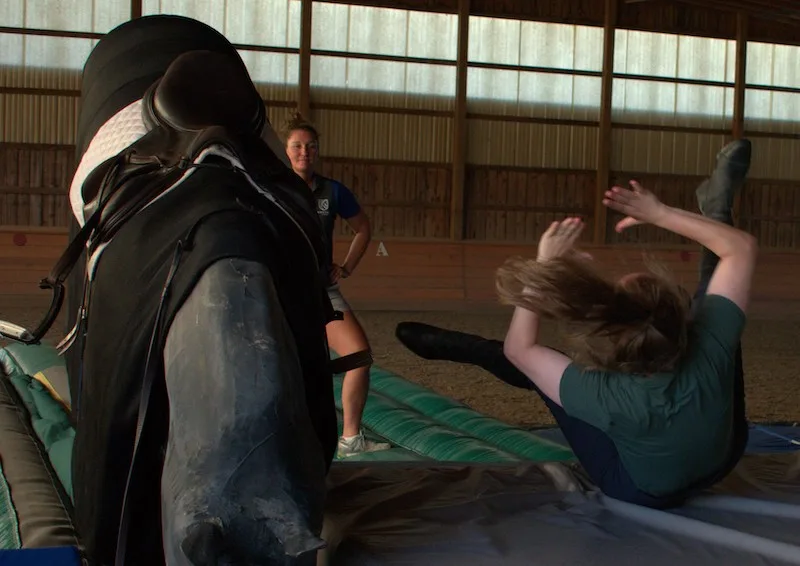One of the most significant falls in my life occurred about 18 years ago. I remember the entire incident quite well because I did not hit my head.
I was on a young race horse who began to lose her marbles on the grassy area between the track and the barn. She wasn’t crazy, she just wanted to go back to the barn, emphatically. She went up and she went down, and she leapt in between, several times. Finally, as she jumped up, she sent me further up and then left me in the air like Wile E. Coyote holding an “Oops” sign. I went down harder than I went up, and I watched my arms and my hands hit the ground before the rest of me, thinking, “Well, crap.” Not even joking.
I broke both of my arms that morning. One needed two surgeries and an external fixator, and the other was my elbow, so it just prevented me from putting my hair in a ponytail (thanks, by the way, to all the random ladies in stores who helped with that over those weeks!) and necessitated me cutting off my own clothes that first night.
Until a few weeks ago, when we hosted a LandSafe clinic at our farm, I always looked at my decisions in that fall as a mistake. Why did I put out my hands? You’re not supposed to do that, right?
The force of that fall turned my wrist into dust. That’s what they told me—dust. The radiograph looked like a hand, a jumble of rocks, and then the rest of my arm on the other side. I was told I would never have full range of motion again and that it would always bother me. Just goes to show you that you can’t ride a radiograph because I do have full range of motion, and it literally never bothers me, ever, but I digress. (We’ll talk about PPEs another time.)
If my hands had not gone out, what would I have hit? My head, 100 percent. If older, retired jockeys run up to you after a fall, exclaiming how it was one of the worst of its kind they’d seen, you know it must have been dramatic, but I got right up, laughing in chagrin and cradling my mangled arm. I was fine. What if that was my head someone else was cradling? I can promise you I wouldn’t have gotten up the same way.
LandSafe has changed the way I look at that fall, though it had always changed the trajectory of my life. Because of that tumble, I went to work for my now-husband, and that statement alone pretty much tells that story. But now I realize that sticking my hands out was not a mistake. There were plenty of other mistakes that happened that day, but breaking my arms was not one of them. Breaking my skull would have been.
If there is an art to riding, there is a science to falling, and that is what Danny and Keli Warrington have broken down, creating the system of LandSafe Equestrian. Danny’s long career of steeplechase riding (hence, falling) and eventing, coupled with Keli’s equestrian and gymnastic background (also falling, but more on purpose), have created this engine for change in the way we think and react, and the way we train for both. They are opening up a dialogue that has long been hush-hush in equestrian sports, and we, as riders, trainers and coaches, are grateful.
The clinic, held over two days, includes learning a progression of basic tumbling moves on gymnastics equipment and well-padded mats—forward rolls and sideways rolls, with increasing speed and complexity, and lots and lots of repetition to ingrain them in your muscle memory. The focus is on protecting your head above all else, and dissipating the energy of the fall and rolling safely out of the way. Then you move on to the simulator, which is basically the mechanical bull you always wanted to ride in your local honky-tonk bar, but with an English saddle and a horsehead on it.
Here’s a video showing many of the skills learned over two days:
Right about the time that LandSafe was gaining ground, I had my first and only full rotational fall. That’s pretty good considering the amount of ludicrous things I’ve done on a horse, but still. Was it on cross-country? Over a big fence? Wild horse? Nope. It was over a small vertical, and the young horse caught the rail between its front legs and tripped. My first thought as it was happening was that I needed to stay still so he could regain his footing, and then I realized that that was not going to happen, and I needed to get off. My basic (albeit excellent) training in jiu-jitsu enabled me to jump and roll, and I distinctly remember thinking that I was so happy I’d been flipped and rolled so many times. (I repeat: so many times. Thanks, River Bend Brazilian Jiu-Jitsu.) My “skills” were enough for that fall, but that fall alone. If anything else had gone wrong, or just differently, it could have been a vastly different situation. I also have guardian angels, so that helps. That close call made me immediately email LandSafe, but truly, we shouldn’t wait for the close call.
ADVERTISEMENT

My husband Tom practices a forward roll, with assistance from Keli (left) and Danny Warrington. Clare Mansmann Photo
At Pacific Farms, we are passionate, and possibly a little obstinate, about the fundamentals. It’s because we’ve seen a lot and done plenty we wish we could change. We teach our OTTBs from the ground up, regardless of what their history is. Sometimes they skate through early lessons because of their history, but we wouldn’t know that unless we tested it out. Sometimes they take a bit of extra work because of their history, but our goal is to not leave any holes. We are not perfect, but we are trying, and we allow the horse to teach us to be better.
We teach our riders the same way. (Riders are way harder than horses, but we love you all, I promise.) People often come for jumping lessons and wind up working on their posting. (Sorry.) LandSafe fits right in with what we spend our days studying, and while we want to teach the preventative medicine of position and horsemanship, we can’t expect everything to go perfectly in the saddle every time. We make mistakes, the horse makes mistakes, and we make even more mistakes when we let fear creep in. We have a whole lot less fear when we have confidence in our balance, our bodies and our training, and in turn, our horses have more confidence in us.
But we can’t learn this ON the horse, not a real one anyway. When we take a tumble, we don’t hop back on to jump off again so we can perfect the experience. There are no second chances on any one fall because there are too many variables. The only people who really have the chance to fall enough to get good at it are race riders and stunt doubles.
Fortunately, we can learn from those kooks. Our falls don’t need to be the definition of defeat and failure but can be a “whoops” moment, where we roll away already ready to remount, with just a few bruises to ourselves and likely our pride (though we can all use that at times). We can analyze what happened and fix it.

“Don’t put your arms out to break your fall!” Wrong! DO put your arms out, just do it the right way, as demonstrated by Zenya Lepper, with assistance from Keli Warrington. Courtney Garber Photo
We work on all aspects of riding. We take flat lessons, jump lessons, we learn from farriers and veterinarians and dentists and saddle fitters, and we research helmets and vests and half pads and boots and gloves and bits and browbands, and whether whiskers are good or bad, and whether alfalfa is good or bad (it’s good, FYI), and what grain and supplements are best, what studs to use, the size of spurs, martingale choices, what color horses can see, and how to best cool them off after exercise. We are missing a critical part of riding if we don’t talk about falling, openly and productively.
Hey, listen. I don’t want to fall either, but if I’m gonna do it, I’m at least gonna look good and also reduce how much I get hurt. (It’s still going to hurt.) An important takeaway from LandSafe, if you didn’t know this already, is that riding is actually the opposite of falling off. So either things went pear-shaped despite your excellent position, and it’s time to throw it out the window to protect yourself, or you weren’t riding well, and that’s what got you into the situation in the first place. It’s no longer the time to equitate when you’re leaving the saddle. For instance:
Staying on the horse: Elbows in.
Falling off the horse: Elbows out.
Staying on the horse: Hands down (but not too far).
Falling off the horse: Hands in front of your face (but not too close).
Staying on the horse: Chin up.
Falling off the horse: CHIN DOWN!
ADVERTISEMENT
Staying on the horse: Look where you want to go.
Falling off the horse: Actually, look where you want to go, the location has just changed, so move your eyes.
Staying on the horse: Upper body as tall as you can.
Falling off the horse: Round your body as tight as you can.
Staying on the horse: Hold your reins.
Falling off the horse: Let go of your reins!
Staying on the horse: Stay close to the saddle.
Falling off the horse: Get away from the saddle.

Zenya Lepper “falling” off the simulator, rolling to safety and protecting her head with her hands. Courtney Garber Photo
LandSafe says to fight the ground, that it wants to open you up, and boy are they right. You may not have realized it during your last fall because it was all a blur. The beauty of the program is the ability to slow it down, teach your brain to stay in the game, and learn to protect said brain on a surface that is more forgiving. There are levels to the program where they add gear and speed, but the foundation of gymnastics teachings and the explanation of handling impact remain the same, and they work because we don’t fall that fast. We think we fall fast because our brains speed everything up in panic, but the reality is kind of painfully slow. Just ask your coach.
That said, many folks have asked how the program could work without moving quickly. Well, how did you learn to ride a horse, to jump a horse, to do anything with a horse? Slowly. We learned over poles, in longe lessons with no hands, no stirrups, eyes closed. We learned slowly. We crawled before we walked, and we trotted into 18 feet before we cantered a course. And if you didn’t, let’s talk, please.
Horse sports have a bad rap for being dangerous, but how many of those statistics could have been avoided by better riding or better falling? We owe it to ourselves, our families and friends, and to the longevity of our sport and profession to do better, and I am excited about the future of LandSafe to do just that. It truly is the most important clinic you can take, for any and all riders of all ages, shapes and disciplines, and one you will not regret making the time for.
Clare and Tom Mansmann operate Pacific Farms, Inc. in Hume, Virginia, where they ride and train a variety of horses but specialize in off-track Thoroughbreds.















